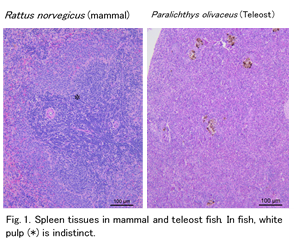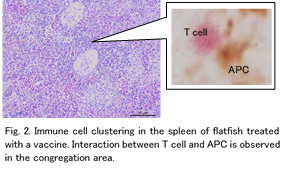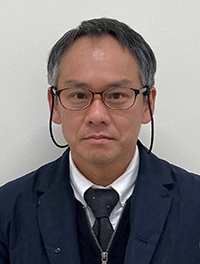Name of supervisor: Osamu Kurata, PhD
Position: Professor
researchmap
KAKEN researcher number: 90277666
ORCID ID0000-0003-0215-0240
Main research theme: Study of lymphoid organs in fish
Research keywords: inducible lymphoid tissues, immune response, vaccine, Paralichthys olivaceus
Lab location: Laboratory of Aquatic Medicine, 2nd floor, Building D
E-mail: kurata(@mark)nvlu.ac.jp
Research
Inducible lymphoid tissues in the spleen of teleost fish
Interaction between immune cells, which are essential for the triggering of acquired immunity, take place in an “immune base” called secondary lymphoid tissue. In mammals, the lymph nodes are the main “immune base”, but fish do not have lymph nodes. Given the effectiveness of vaccines against infectious diseases in aquacultured fish, fish should also have an “immune base”. The spleen also plays a role as the “immune base”, but its organisational structure differs greatly between mammals and fish (Fig. 1).
Our research group revealed the phenomenon of immune cells clustering in a specific area of the spleen in flatfish (Paralichthys olivaceus) treated with a vaccine (bacterin) (Fig. 2). Contact between T cells, which are responsible for acquired immunity, and antigen-presenting cells (APC) was observed in these congregating areas, suggesting that cell-cell interactions may be taking place. Our research is currently underway to analyze the structural and functional characteristics of the spleen immune microenvironment induced by vaccine administration and to elucidate the fish-specific ‘immune base’.


Guidance policy for graduate students
I welcome everyone with various interests, such as “I want to discover the unique immune system of fish”, “I want to explore the universal immune system of animals through fish” or “I want to explore the immune function of fish and contribute to the development of preventive technology against fish infectious diseases”. I strive to provide guidance that respects the students’ independence, and want to help students to be able to work towards their research goal.
Publications
1.Osamu Kurata, Miyabi Haneji, Kawashima Takuya, Masaru Yagisawa, Satoru Saito, Tatsuya Mori. Efficacy of Oxilink-SP at inhibiting infection of Salmonid eggs by water mold, Saprolegnia spp. Fish Pathology, 57(3) 95-102, 2022. doi: 10.3147/jsfp.57.95.
2.Osamu Kurata, Suyu Miyashita, Shinpei Wada. Histological distribution of MHC class II‒expressing cells responsible for ingestion of blood‒borne exogenous particles in Japanese flounder Paralichthys olivaceus. Fish Pathology, 56(4) 216-219, 2021. doi: 10.3147/jsfp.56.216.
3.Osamu Kurata, Suyu Miyashita, Shusei Toda, Shinpei Wada, Takamitsu Sakai. Immunohistochemistry for detection of MHC class II-expressingcCells in Japanese flounder Paralichthys olivaceus. Fish Pathology, 55(4) 151-161, 2021. doi: 10.3147/jsfp.55.151.
4.Yozo Takada, Kosei Taguchi, Kyuma Suzuki, Akihiko Ashizawa, Koichi Kaji, Shun Watanabe, Shinpei Wada, Osamu Kurata. Subsequent changes in the thymus of ayu Plecoglossus altivelis reared from juveniles with temperature-induced differential thymus growth. Fish Pathology, 55(2) 31-37, 2020. doi: 10.3147/jsfp.55.31.
5.Yih Nin Lee, Shinpei Wada, Osamu Kurata. Effect of age on the susceptibility of marbled rockfish, Sebastiscus marmoratus to Ochroconis humicola following experimental challenge. Journal of Fish Diseases, 43(3) 399-401, 2020. doi: 10.1111/jfd.13131.



